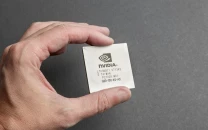Electric cars need to lose weight, power up and cool down
Mercedez-Benz is looking for start-up companies to make electric cars lighter in weight and with more efficient motors

Speed has always been a top priority for supercar makers, and they are now in the race of their lives to use electricity before climate policy cuts down on combustion engines.
So Ferrari, Mercedes-Benz are looking for start-ups such as Oxford-based electric motor company YASA to have the expertise and technology to solve the unique challenge of electrifying the highest performance vehicles.
Batteries are very heavy and electric motors can overheat if driven too hard. This is a big problem for niche industries that charge hundreds of thousands of dollars for lightweight cars that can scream 10 laps of a truck at full throttle.
This year, Daimler purchased YASA. YASA has developed an “Axial Flux” high performance electric motor that weighs 23 kg (50.7 lb). handle.
YASA already manufactures motors for Swedish supercar maker Koenigsegg and the unknown British supercar company Ferrari. Daimler supplies the high-performance AMG brand and will soon become the name of the automotive business Mercedes-Benz.
Based just a few miles from YASA, Saietta has developed a variety of water-cooled axial flux motors. The company is preparing to produce motors for the vast Asian motorcycle market, but is making a larger prototype for Reuters and is in talks with one hypercar maker, two of which are of interest. He said he showed it.
“These manufacturers know the combustion engine forward, backward, and inside out,” said Graham Lenden, Chief Commercial Officer of Saietta. “But they don’t know the electric drivetrain, and they’re looking for someone to hold their hand.”
However, this is an unknown territory, and there is not yet a clear roadmap to electricity for high-performance vehicles. Supercar makers need to invest billions of dollars to survive the disappearance of combustion engines, and there is no guarantee that the technology they employ will pay off in the long run.
Weight is an enemy
Supercars and top-of-the-line hypercars (both sports cars approaching professional race-level performance) are highly profitable and capital-intensive niche markets for automakers.
Consultant AlixPartners and data company IHS Markit will market more than 152,000 “luxury” and “ultra-luxury” sports cars worldwide in 2021 with prices between £ 100,000 and £ 10 million ($ 137,000 to $ 13.7 million). Is projected to rise by nearly 50. Up to 223,000 units in 2026.
However, YASA founder Woolmer said his company’s long-term briefs from Daimler will allow German automakers to use them in all models when moving to electricity in the future iterations of the motor. He said it was to reduce costs.
“Automotive technology doesn’t grow in volume overnight. You tend to start in the premium niche sector,” says Woolmer.
Ultimately, manufacturers of high-performance electric vehicles need to find ways to develop lighter, more powerful batteries. However, today’s battery technology cannot compete with the sustained power of gasoline engines, so we are rethinking everything from electric motors to body materials.
Axial flux electric motors are flat, round devices called “panques” that are lighter and more efficient than traditional cylindrical “radial flux” motors or “sausages”.
YASA’s motors are oil-cooled, so they won’t overheat and are much more efficient than traditional motors, so they developed the device as part of their PhD at Oxford University and founded the company in 2009. Said Tim Woolmer.
Motors are more efficient and can extend the range of electric vehicles by up to 7%. Also, because of its low power consumption, automakers can take out some of the heavy batteries and reduce the weight of the vehicle by up to 10%. ..
YASA has a small facility at its Oxford headquarters, manufacturing motors for Ferrari’s SF90 Stradale hybrid model and 296 GTB hybrid model, as well as test motors for AMG. Daimler is researching ways to expand its production in its own factories.
Chris Harris, CEO of YASA, said the acquisition by the German giant has not ended work with clients like Ferrari.
“They want us to continue working with supercar customers because it’s cutting edge,” he added. “The technology cascades down as it matures.”
Ferrari’s Chief Technical Officer Michael Raters described the hybrid model YASA Motor as “car first,” adding that Italian sports car makers rely on their suppliers’ technical expertise in their quest for electric vehicles. rice field.
Recruitment: Battery Revolution
Car companies are also looking beyond motors in their weight loss plans.
Mate Rimac, CEO of Croatian electric hypercar maker Rimac, said that the chassis and body of the C-Two model are both made of carbon fiber, and the battery forms part of the car’s structure for weight savings. Said.
The company has established a joint venture with Volkswagen’s luxury sports car unit. Porsche It includes VW Bugatti The brand also uses “torque vectoring” to improve performance-wheel motors to help take corners.
British sports car maker Lotus has developed a new electric platform using lightweight aluminum alloy. This will reduce the structural weight of the vehicle by 37% and will begin production of the first fully electric sports car in 2026.
Lotus is owned by Geely of China and Etica Automotive of Malaysia, and is also active as an automobile supplier and engineer for other automakers. According to managing director Matt Windle, the company is in talks to supply the platform to another automaker and has received interest from several other automakers.
“Given the cost and speed of electrification, collaboration is the way to go,” Windle said.
Chinese automaker FAW has partnered with US-based engineering and design company Silk EV to establish a Silk-FAW venture that plans to manufacture electric sports cars in Italy.
We are looking at high speed motors that use carbon fiber components in the vehicle chassis and use copper wiring technology in the aerospace sector to reduce the weight of the motor by 20%, but we are also looking at other options.
“Lightening is even more important than higher levels of electricity,” said Roberto Fedeli, Vice President of Innovation and Technology at Silk-FAW.
For most wealthy sports car buyers who use their car for recreation or commuting and don’t want to perform multiple high-speed laps around the race track, just reduce weight and use more efficient motors. May be enough.
Those who do so can wait for a long time.
“Unless the battery revolutionizes, it will never carry the amount of energy a fuel tank carries,” said Woolmer, founder of YASA.
“For longer forms of racing, it will be for a while.”



















COMMENTS
Comments are moderated and generally will be posted if they are on-topic and not abusive.
For more information, please see our Comments FAQ